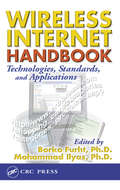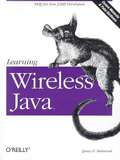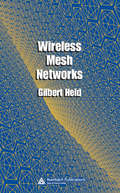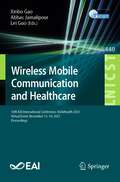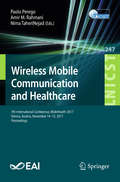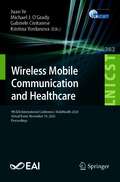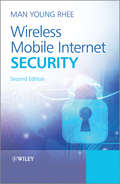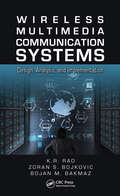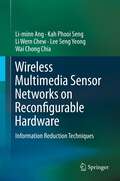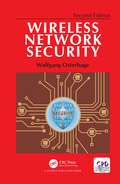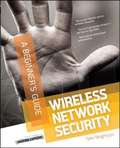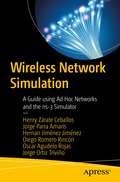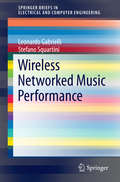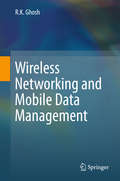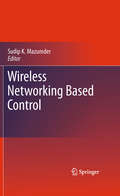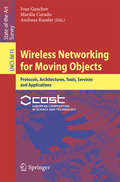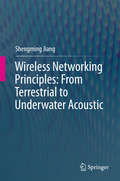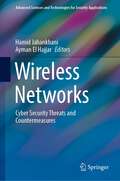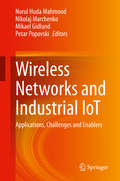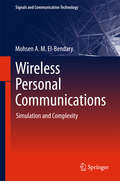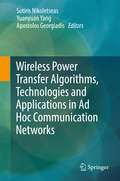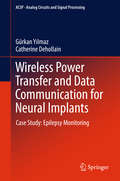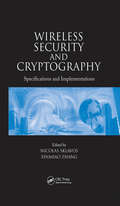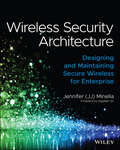- Table View
- List View
Wireless Internet Handbook: Technologies, Standards, and Applications (Internet And Communications)
by Borko Furht and Mohammad IlyasWireless applications are definitely the next big thing in communications. Millions of people around the world use the Internet every day - to stay in touch with remote locations, follow the stock market, keep up with the news, check the weather, make travel plans, conduct business, shop, entertain themselves, and learn. The logical next step is th
Wireless Java
by Qusay MahmoudLearning Wireless Java is for Java developers who want to quickly come up to speed and create applications for the Micro Edition audience. This book covers the Connected, Limited Device Configuration and the Mobile Information Device Profile (MIDP), both currently available from Javasoft. The CLDC contains APIs for small devices that are constrained by both memory and processing power. MIDP builds on top of the CLDC and adds APIs specifically for devices such as mobile phones and pagers, allowing programmers to create MIDlet applications. This book offers a solid introduction to J2ME and MIDP, including an explanation of the J2ME Wireless Toolkit, the MIDlet lifecycle methods, the Java application manager, and the CLDC and MIDP constraints. In addition, we cover the javax.microedition.io, javax.microedition.rms, javax.microedition.lcdui, and javax.microedition.midlet classes, as well as the modified java.lang, java.io, and java.util classes. Discussion centers around building safe, compact applications with the sophisticated graphical interface, database, and networking capabilities that the J2ME supports. In addition, this book also shows you how to download your applications to the latest J2ME-enabled devices, including the Motorola i50x and i85s phones and upgraded Palm handhelds.
Wireless Mesh Networks
by Gilbert HeldWireless mesh networking is a new technology that has the potential to revolutionize how we access the Internet and communicate with co-workers and friends. Wireless Mesh Networks examines the concept and explores its advantages over existing technologies. This book explores existing and future applications.
Wireless Mobile Communication and Healthcare: 10th EAI International Conference, MobiHealth 2021, Virtual Event, November 13–14, 2021, Proceedings (Lecture Notes of the Institute for Computer Sciences, Social Informatics and Telecommunications Engineering #440)
by Xinbo Gao Abbas Jamalipour Lei GuoThis book constitutes the refereed post-conference proceedings of the 10th International Conference on Mobile Communication and Healthcare, MobiHealth 2021, held in November 2021. Due to Covid-19 pandemic the conference was held virtually.
Wireless Mobile Communication and Healthcare: 7th International Conference, Mobihealth 2017, Vienna, Austria, November 14-15, 2017, Proceedings (Lecture Notes of the Institute for Computer Sciences, Social Informatics and Telecommunications Engineering #247)
by Nima TaheriNejad Amir M. Rahmani Paolo PeregoThis book constitutes the refereed post-conference proceedings of the 7th International Conference on Mobile Communication and Healthcare, MobiHealth 2017, held in Vienna, Austria, in November 2017. The 34 revised full papers were reviewed and selected from more than 50 submissions and are organized in topical sections covering data analysis, systems, work-in-process, pervasive and wearable health monitoring, advances in healthcare services, design for healthcare, advances in soft wearable technology for mobile-health, sensors and circuits.
Wireless Mobile Communication and Healthcare: 9th EAI International Conference, MobiHealth 2020, Virtual Event, November 19, 2020, Proceedings (Lecture Notes of the Institute for Computer Sciences, Social Informatics and Telecommunications Engineering #362)
by Juan Ye Michael J. O’Grady Gabriele Civitarese Kristina YordanovaThis book constitutes the refereed post-conference proceedings of the 9th International Conference on Mobile Communication and Healthcare, MobiHealth 2020, held in December 2020. Due to Covid-19 pandemic the conference was held virtually. The book contains 13 full papers selected from the main conference and 10 full papers from two workshops on medical artificial intelligence and on digital healthcare technologies. The conference papers are organized in topical sections on wearable technologies; health telemetry; mobile sensing and assessment; machine learning in eHealth applications.
Wireless Mobile Internet Security
by Man Young RheeThe mobile industry for wireless cellular services has grown at a rapid pace over the past decade. Similarly, Internet service technology has also made dramatic growth through the World Wide Web with a wire line infrastructure. Realization for complete wired/wireless mobile Internet technologies will become the future objectives for convergence of these technologies through multiple enhancements of both cellular mobile systems and Internet interoperability. Flawless integration between these two wired/wireless networks will enable subscribers to not only roam worldwide, but also to solve the ever increasing demand for data/Internet services. In order to keep up with this noteworthy growth in the demand for wireless broadband, new technologies and structural architectures are needed to greatly improve system performance and network scalability while significantly reducing the cost of equipment and deployment. Dr. Rhee covers the technological development of wired/wireless internet communications in compliance with each iterative generation up to 4G systems, with emphasis on wireless security aspects. By progressing in a systematic matter, presenting the theory and practice of wired/wireless mobile technologies along with various security problems, readers will gain an intimate sense of how mobile internet systems operate and how to address complex security issues. Features: Written by a top expert in information security Gives a clear understanding of wired/wireless mobile internet technologies Presents complete coverage of various cryptographic protocols and specifications needed for 3GPP: AES, KASUMI, Public-key and Elliptic curve cryptography Forecast new features and promising 4G packet-switched wireless internet technologies for voice and data communications Provides MIMO/OFDMA-based for 4G systems such as Long Term Evolution (LTE), Ultra Mobile Broadband (UMB), Mobile WiMax or Wireless Broadband (WiBro) Deals with Intrusion Detection System against worm/virus cyber attacks The book ideal for advanced undergraduate and postgraduate students enrolled in courses such as Wireless Access Networking, Mobile Internet Radio Communications. Practicing engineers in industry and research scientists can use the book as a reference to get reacquainted with mobile radio fundamentals or to gain deeper understanding of complex security issues.
Wireless Multimedia Communication Systems: Design, Analysis, and Implementation
by K.R. Rao Zoran S. Bojkovic Bojan M. BakmazRapid progress in software, hardware, mobile networks, and the potential of interactive media poses many questions for researchers, manufacturers, and operators of wireless multimedia communication systems. Wireless Multimedia Communication Systems: Design, Analysis, and Implementation strives to answer those questions by not only covering the underlying concepts involved in the design, analysis, and implementation of wireless multimedia communication systems, but also by tackling advanced topics such as mobility management, security components, and smart grids. Offering an accessible treatment of the latest research, this book: Presents specific wireless multimedia communication schemes that have proven to be useful Discusses important standardization processing activities regarding wireless networking Includes wireless mesh and multimedia sensor network architectures, protocols, and design optimizations Highlights the challenges associated with meeting complex connectivity requirements Contains numerous figures, tables, examples, references, and a glossary of acronyms Providing coverage of significant technological advances in their initial steps along with a survey of the fundamental principles and practices, Wireless Multimedia Communication Systems: Design, Analysis, and Implementation aids senior-level and graduate-level engineering students and practicing professionals in understanding the processes and furthering the development of today’s wireless multimedia communication systems.
Wireless Multimedia Sensor Networks on Reconfigurable Hardware
by Li-Minn Ang Kah Phooi Seng Li Wern Chew Lee Seng Yeong Wai Chong ChiaTraditional wireless sensor networks (WSNs) capture scalar data such as temperature, vibration, pressure, or humidity. Motivated by the success of WSNs and also with the emergence of new technology in the form of low-cost image sensors, researchers have proposed combining image and audio sensors with WSNs to form wireless multimedia sensor networks (WMSNs). This introduces practical and research challenges, because multimedia sensors, particularly image sensors, generate huge amounts of data to be processed and distributed within the network, while sensor nodes have restricted battery power and hardware resources. This book describes how reconfigurable hardware technologies such as field-programmable gate arrays (FPGAs) offer cost-effective, flexible platforms for implementing WMSNs, with a main focus on developing efficient algorithms and architectures for information reduction, including event detection, event compression, and multicamera processing for hardware implementations. The authors include a comprehensive review of wireless multimedia sensor networks, a complete specification of a very low-complexity, low-memory FPGA WMSN node processor, and several case studies that illustrate information reduction algorithms for visual event compression, detection, and fusion. The book will be of interest to academic researchers, R&D engineers, and computer science and engineering graduate students engaged with signal and video processing, computer vision, embedded systems, and sensor networks.
Wireless Network Security: Second Edition
by Wolfgang OsterhageWireless communications have become indispensable part of our lives. The book deals with the security of such wireless communication. The technological background of these applications have been presented in detail. Special emphasis has been laid on the IEEE 802.11x-standards that have been developed for this technology. A major part of the book is devoted to security risks, encryption and authentication. Checklists have been provided to help IT administrators and security officers to achieve the maximum possible security in their installations, when using wireless technology. This is the second edition of the book. The updates include the latest the IEEE 802.11-standard, an updated chapter on PDA, the increased relevance of smart phones and tablets, widespread use of WLAN with increased security risks.
Wireless Network Security
by Brock Pearson Tyler WrightsonSecurity Smarts for the Self-Guided IT Professional Protect wireless networks against all real-world hacks by learning how hackers operate. "Wireless Network Security: A Beginner's Guide" discusses the many attack vectors that target wireless networks and clients--and explains how to identify and prevent them. Actual cases of attacks against WEP, WPA, and wireless clients and their defenses are included. This practical resource reveals how intruders exploit vulnerabilities and gain access to wireless networks. You'll learn how to securely deploy WPA2 wireless networks, including WPA2-Enterprise using digital certificates for authentication. The book provides techniques for dealing with wireless guest access and rogue access points. Next-generation wireless networking technologies, such as lightweight access points and cloud-based wireless solutions, are also discussed. Templates, checklists, and examples give you the hands-on help you need to get started right away. "Wireless Network Security: A Beginner's Guide" features: Lingo--Common security terms defined so that you re in the know on the job IMHO--Frank and relevant opinions based on the author's years of industry experience In Actual Practice--Exceptions to the rules of security explained in real-world contexts Your Plan--Customizable checklists you can use on the job now Into Action--Tips on how, why, and when to apply new skills and techniques at work "This is an excellent introduction to wireless security and their security implications. The technologies and tools are clearly presented with copious illustrations and the level of presentation will accommodate the wireless security neophyte while not boring a mid-level expert to tears. If the reader invests the time and resources in building a lab to follow along with the text, s/he will develop a solid, basic understanding of what "wireless security" is and how it can be implemented in practice. This is definitely a recommended read for its intended audience. " - Richard Austin, IEEE CIPHER, IEEE Computer Society's TC on Security and Privacy (E109, July 23, 2012) "
Wireless Network Simulation: A Guide using Ad Hoc Networks and the ns-3 Simulator
by Henry Zárate Ceballos Jorge Ernesto Parra Amaris Hernan Jiménez Jiménez Diego Alexis Romero Rincón Oscar Agudelo Rojas Jorge Eduardo Ortiz TriviñoLearn to run your own simulation by working with model analysis, mathematical background, simulation output data, and most importantly, a network simulator for wireless technology. This book introduces the best practices of simulator use, the techniques for analyzing simulations with artificial agents and the integration with other technologies such as Power Line Communications (PLC).Network simulation is a key technique used to test the future behavior of a network. It’s a vital development component for the development of 5G, IoT, wireless sensor networks, and many more. This book explains the scope and evolution of the technology that has led to the development of dynamic systems such as Internet of Things and fog computing. You'll focus on the ad hoc networks with stochastic behavior and dynamic nature, and the ns-3 simulator. These are useful open source tools for academics, researchers, students and engineers to deploy telecommunications experiments, proofs and new scenarios with a high degree of similarity with reality. You'll also benefit from a detailed explanation of the examples and the theoretical components needed to deploy wireless simulations or wired, if necessary.What You’ll LearnReview best practices of simulator usesUnderstand techniques for analyzing simulations with artificial agentsApply simulation techniques and experiment designProgram on ns-3 simulatorAnalyze simulation resultsCreate new modules or protocols for wired and wireless networksWho This Book Is ForUndergraduate and postgraduate students, researchers and professors interested in network simulations. This book also includes theoretical components about simulation, which are useful for those interested in discrete event simulation DES, general theory of simulation, wireless simulation and ns-3 simulator.
Wireless Networked Music Performance
by Leonardo Gabrielli Stefano SquartiniThisbook presents a comprehensive overview of the state of the art in NetworkedMusic Performance (NMP) and a historical survey of computer music networking. It introduces current technical trends in NMP and technical issues yet to beaddressed. It also lists wireless communication protocols and compares these to the requirements of NMP. Practicaluse cases and advancements are also discussed.
Wireless Networking and Mobile Data Management
by R. K. GhoshThis book examines two main topics, namely, Wireless Networking and Mobile Data Management. It is designed around a course the author began teaching to senior undergraduate and master's students at the Department of Computer Science & Engineering of the Indian Institute of Technology Kanpur. The first part of the book, consisting of eight chapters, including the introduction, focuses exclusively on wireless networking aspects. It begins with cellular communication systems, which provided the foundation of wireless networking principles. Three subsequent chapters are devoted to the Global System for Mobile communication (GSM), Wireless Local Area Network (WLAN), Bluetooth, infrared (IR), ZigBee and 6LoWPAN protocols. There is also a chapter on routings in ad hoc networks, an area that is currently being intensively researched due to its potential applications in areas of vehicular network, traffic management, tactical and military systems. Furthermore, the book discusses mobile operating systems and wireless network application level protocols such as Wireless Application Protocols (WAP), Mobile IP and Mosh. The second part highlights mobile data management. It addresses the issues like location management, the importance of replication and caching in mobile environments, the concept of broadcast disk and indexing in air, storage systems for sharing data in mobile environments, and building smart environments. Given that the design of algorithms is the key to applications in data management; this part begins with a chapter on the type of paradigm shift that has been introduced in the design of algorithms, especially due to asymmetry in mobile environments. Lastly, the closing chapter of the book explores smart environments, showing the readers how wireless technology and mobile data management can be combined to provide optimum comfort for human life. Though the book has been structured as a monograph, it can be used both as a textbook and as a reference material for researchers and developers working in the area.
Wireless Networking Based Control
by Sudip K. MazumderThis book will have a broad appeal in the area of Wireless Networking-Based Control. Various engineering disciplines, control and communication science organizations will be interested in purchasing the book with a new, emerging, and important theme. Also, industry such as Honeywell and those (e.g. power industry, automotive industry, aerospace industry) interested in implementing wireless network control to express interest in purchasing this book.
Wireless Networking for Moving Objects: Protocols, Architectures, Tools, Services and Applications (Lecture Notes in Computer Science #8611)
by Ivan Ganchev, Marília Curado and Andreas KasslerWireless networks of moving objects have drawn significant attention recently. These types of networks consist of a number of autonomous or semi-autonomous wireless nodes/objects moving with diverse patterns and speeds while communicating via several radio interfaces simultaneously. To overcome current shortcomings, a number of research challenges have to be addressed in this area, ranging from initial conceptualization and modelling, to protocols and architectures engineering, and development of suitable tools, applications and services, and to the elaboration of realistic use-case scenarios by taking into account corresponding societal and economic aspects. By applying a systematic approach the objective of this book is to assess the state of the art and consolidate the main research results achieved in this area. It was prepared as the Final Publication of the COST Action IC0906 “Wireless Networking for Moving Objects (WiNeMO)”. The book contains 15 chapters and is a show-case of the main outcomes of the action in line with its scientific goals. The book will serve as a valuable reference for undergraduate students, post-graduate students, educators, faculty members, researchers, engineers, and research strategists working in this field.
Wireless Networking Principles: From Terrestrial to Underwater Acoustic
by Shengming JiangThis book systematically summarizes the fundamentals and various technologies in both terrestrial radio wireless networks and underwater acoustic networks (UWANs). It addresses the basic issues frequently investigated in terrestrial radio wireless networks and the key technologies suitable for the newly developing research area of UWANs. Starting with a review of our current understanding of wireless networks, it then introduces the principles of the main technologies, including error control, medium access control (MAC) protocols, routing protocols, end-to-end transmission control and mobility issues as well as network security for terrestrial radio wireless networks, and offers detailed surveys of these technologies for UWANs.Providing readers with the basic knowledge of terrestrial radio wireless networking technologies and raising readers’ awareness of the developing topic of UWANs in ocean , it is a valuable resource for researchers and practitioners in terrestrial radio wireless networks and UWANs.
Wireless Networks: Cyber Security Threats and Countermeasures (Advanced Sciences and Technologies for Security Applications)
by Hamid Jahankhani Ayman El HajjarIn recent years, wireless networks communication has become the fundamental basis of our work, leisure, and communication life from the early GSM mobile phones to the Internet of Things and Internet of Everything communications. All wireless communications technologies such as Bluetooth, NFC, wireless sensors, wireless LANs, ZigBee, GSM, and others have their own challenges and security threats. This book addresses some of these challenges focusing on the implication, impact, and mitigations of the stated issues. The book provides a comprehensive coverage of not only the technical and ethical issues presented by the use of wireless networks but also the adversarial application of wireless networks and its associated implications. The authors recommend a number of novel approaches to assist in better detecting, thwarting, and addressing wireless challenges and threats. The book also looks ahead and forecasts what attacks can be carried out in the future through the malicious use of the wireless networks if sufficient defenses are not implemented. The research contained in the book fits well into the larger body of work on various aspects of wireless networks and cyber-security. The book provides a valuable reference for cyber-security experts, practitioners, and network security professionals, particularly those interested in the security of the various wireless networks. It is also aimed at researchers seeking to obtain a more profound knowledge in various types of wireless networks in the context of cyber-security, wireless networks, and cybercrime. Furthermore, the book is an exceptional advanced text for Ph.D. and master’s degree programs in cyber-security, network security, cyber-terrorism, and computer science who are investigating or evaluating a security of a specific wireless network. Each chapter is written by an internationally-renowned expert who has extensive experience in law enforcement, industry, or academia. Furthermore, this book blends advanced research findings with practice-based methods to provide the reader with advanced understanding and relevant skills.
Wireless Networks and Industrial IoT: Applications, Challenges and Enablers
by Nurul Huda Mahmood Nikolaj Marchenko Mikael Gidlund Petar PopovskiThis book provides a comprehensive overview of the most relevant research and standardization results in the area of wireless networking for Industrial IoT, covering both critical and massive connectivity. Most chapters in this book are intended to serve as short tutorials of particular topics, highlighting the main developments and ideas, as well as giving an outlook of the upcoming research challenges.The book is divided into four parts. The first part focuses on challenges, enablers and standardization efforts for reliable low-latency communication in Industrial IoT networks. The next part focuses on massive IoT, which requires cost- and energy-efficient technology components to efficiently connect a massive number of low-cost IoT devices. The third part covers three enabling technologies in the context of Industrial IoT: Security, Machine Learning/Artificial Intelligence and Edge Computing. These enablers are applicable to both connectivity types, critical and massive IoT. The last part covers aspects of Industrial IoT related to connected transportation that are important in, for example, warehouse and port logistics, product delivery and transportation among industries.Presents a comprehensive guide to concepts and research challenges in wireless networking for Industrial IoT;Includes an introduction and overview of such topics as 3GPP standardization for Industrial IoT, Time Sensitive Networking, system dependability over wireless networks, energy-efficient wireless networks, IoT security, ML/AI for Industrial IoT and connected transportation systems;Features contributions by well-recognized experts from both academia and industry.
Wireless Personal Communications: Simulation And Complexity (Signals And Communication Technology)
by Mohsen A. M. El-BendaryThis book introduces wireless personal communications from the point of view of wireless communication system researchers. Existing sources on wireless communications put more emphasis on simulation and fundamental principles of how to build a study model. In this volume, the aim is to pass on to readers as much knowledge as is essential for completing model building of wireless communications, focusing on wireless personal area networks (WPANs). This book is the first of its kind that gives step-by-step details on how to build the WPANs simulation model. It is most helpful for readers to get a clear picture of the whole wireless simulation model by being presented with many study models. The book is also the first treatise on wireless communication that gives a comprehensive introduction to data-length complexity and the computational complexity of the processed data and the error control schemes. This volume is useful for all academic and technical staff in the fields of telecommunications and wireless communications, as it presents many scenarios for enhancing techniques for weak error control performance and other scenarios for complexity reduction of the wireless data and image transmission. Many examples are given to help readers to understand the material covered in the book. Additional resources such as the MATLAB codes for some of the examples also are presented.
Wireless Power Transfer Algorithms, Technologies and Applications in Ad Hoc Communication Networks
by Sotiris Nikoletseas Yuanyuan Yang Apostolos GeorgiadisThis book is the first systematic exposition on the emerging domain of wireless power transfer in ad hoc communication networks. It selectively spans a coherent, large spectrum of fundamental aspects of wireless power transfer, such as mobility management in the network, combined wireless power and information transfer, energy flow among network devices, joint activities with wireless power transfer (routing, data gathering and solar energy harvesting), and safety provisioning through electromagnetic radiation control, as well as fundamental and novel circuits and technologies enabling the wide application of wireless powering. Comprising a total of 27 chapters, contributed by leading experts, the content is organized into six thematic sections: technologies, communication, mobility, energy flow, joint operations, and electromagnetic radiation awareness. It will be valuable for researchers, engineers, educators, and students, and it may also be used as a supplement to academic courses on algorithmic applications, wireless protocols, distributed computing, and networking.
Wireless Power Transfer and Data Communication for Neural Implants
by Gürkan Yilmaz Catherine DehollainThis book presents new circuits and systems for implantable biomedical applications targeting neural recording. The authors describe a system design adapted to conform to the requirements of an epilepsy monitoring system. Throughout the book, these requirements are reflected in terms of implant size, power consumption, and data rate. In addition to theoretical background which explains the relevant technical challenges, the authors provide practical, step-by-step solutions to these problems. Readers will gain understanding of the numerical values in such a system, enabling projections for feasibility of new projects.
Wireless-Powered Communication Networks: Architectures, Protocols, and Applications
by Dusit Niyato Ekram Hossain Dong In Kim Vijay Bhargava Lotfollah ShafaiLearn the fundamentals of architecture design, protocol optimization, and application development for wireless-powered communication networks with this authoritative guide. Readers will gain a detailed understanding of the issues surrounding architecture and protocol design, with key topics covered including relay-based energy harvesting systems, multiple-antenna systems for simultaneous wireless information and power transfer (SWIPT), performance modeling and analysis, and ambient wireless energy harvesting based cellular systems. Current applications of energy harvesting and transfer in different wireless networking scenarios are discussed, aiding the understanding of practical system development and implementation issues from an engineering perspective. The first book to provide a unified view of energy harvesting and wireless power transfer networks from a communications perspective, this is an essential text for researchers working on wireless communication networks and wireless systems, RF engineers, and wireless application developers.
Wireless Security and Cryptography: Specifications and Implementations
by Nicolas Sklavos Xinmiao ZhangAs the use of wireless devices becomes widespread, so does the need for strong and secure transport protocols. Even with this intensified need for securing systems, using cryptography does not seem to be a viable solution due to difficulties in implementation. The security layers of many wireless protocols use outdated encryption algorithms, which have proven unsuitable for hardware usage, particularly with handheld devices. Summarizing key issues involved in achieving desirable performance in security implementations, Wireless Security and Cryptography: Specifications and Implementations focuses on alternative integration approaches for wireless communication security. It gives an overview of the current security layer of wireless protocols and presents the performance characteristics of implementations in both software and hardware. This resource also presents efficient and novel methods to execute security schemes in wireless protocols with high performance. It provides the state of the art research trends in implementations of wireless protocol security for current and future wireless communications. Unique in its coverage of specification and implementation concerns that include hardware design techniques, Wireless Security and Cryptography: Specifications and Implementations provides thorough coverage of wireless network security and recent research directions in the field.
Wireless Security Architecture: Designing and Maintaining Secure Wireless for Enterprise
by Jennifer MinellaReduce organizational cybersecurity risk and build comprehensive WiFi, private cellular, and IOT security solutions Wireless Security Architecture: Designing and Maintaining Secure Wireless for Enterprise offers readers an essential guide to planning, designing, and preserving secure wireless infrastructures. It is a blueprint to a resilient and compliant architecture that responds to regulatory requirements, reduces organizational risk, and conforms to industry best practices. This book emphasizes WiFi security, as well as guidance on private cellular and Internet of Things security. Readers will discover how to move beyond isolated technical certifications and vendor training and put together a coherent network that responds to contemporary security risks. It offers up-to-date coverage—including data published for the first time—of new WPA3 security, Wi-Fi 6E, zero-trust frameworks, and other emerging trends. It also includes: Concrete strategies suitable for organizations of all sizes, from large government agencies to small public and private companies Effective technical resources and real-world sample architectures Explorations of the relationships between security, wireless, and network elements Practical planning templates, guides, and real-world case studies demonstrating application of the included conceptsPerfect for network, wireless, and enterprise security architects, Wireless Security Architecture belongs in the libraries of technical leaders in firms of all sizes and in any industry seeking to build a secure wireless network.
